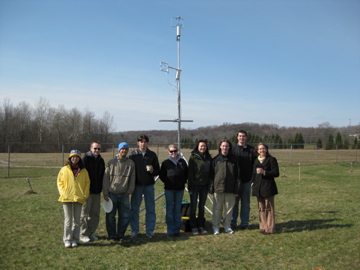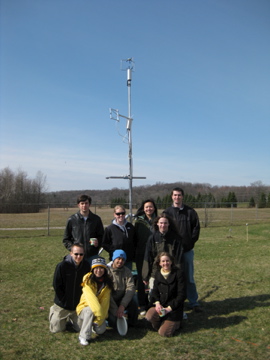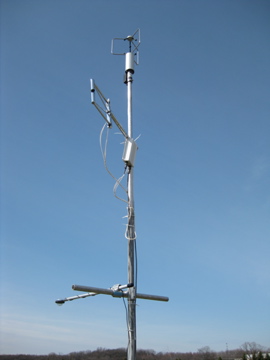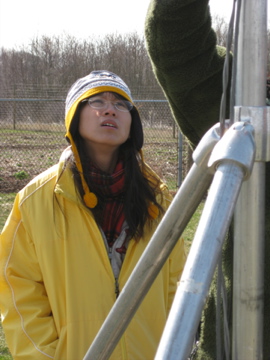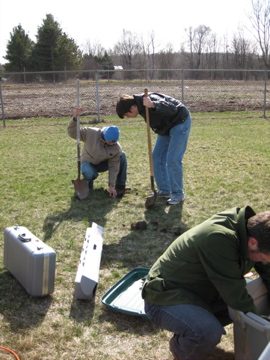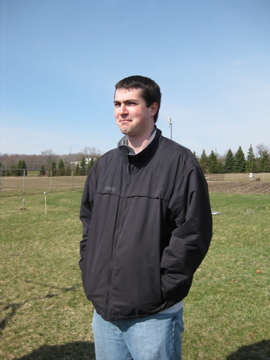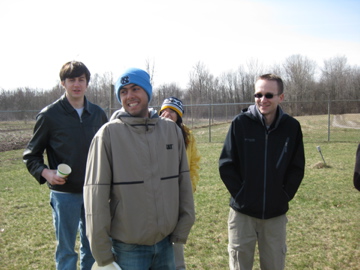· CLIMATE/ENSCEN/CHEM/ENVIRON 105: Our Changing Atmosphere (Winter 2015, 2017, 2019)
This is an introductory course for non-science majors to understand three main questions: (1) How is the atmosphere changing? (2) Why is it changing? and (3) How does this influence past, present and future climate? This includes understanding the basics of the Earth’s energy balance, the science of the greenhouse effect and what makes a good greenhouse gas, and how the composition of the Earth’s atmosphere has been changing over the past 250 years.
· CLIMATE 320: Earth System Evolution (4 credits: Fall 2007, 2009, 2010, 2012, 2019)
CLIMATE 320 is the first core course for undergraduates in CLaSP. The class provides a basic understanding of the main concepts in Earth Science through a combination of lectures and quantitative analysis. The first half of the course focuses on the individual components of the Earth System (atmosphere, ocean, biosphere, solid earth) and the relevant chemical and physical properties. The second half of the course focuses on the evolution of the Earth’s atmosphere and the Earth’s climate from early geological time to the present.
· CLIMATE/SPACE 323: Earth System Analysis (4 credits: W2022)
CLIMATE / SPACE 323 is an introduction to the analysis of Earth and Space science systems. The mathematical topics that will be covered include harmonic analysis, discrete mathematics, sampling theory and statistical error analysis. The course is designed to emphasize a conceptual understanding of the underlying mathematical concepts in lecture and their applications to the analysis of scientific measurements in a programming environment. Current topics in the atmospheric and space sciences are addressed in each of the labs as a means of demonstrating the relevance of the mathematical tools to problems in Earth Systems. The labs are also intended to expose students to the Python programming environment at a level beyond that covered in a typical freshman introductory course. Each lab requires students to write or to modify a considerable amount of Python source code. In addition to coding that is directly related to the topics covered in the lectures, a number of other Python procedures that are often useful for analysis of measurements and model outputs.
· CLIMATE 422: Boundary Layer Meteorology (Winter 2007, 2008, 2009 and 2010; Fall 2011): No longer offered and now taught as Air Pollution Meteorology (CLIMATE 463)
The atmospheric boundary layer is the lowest portion of the atmosphere, representing the interface between the Earth’s surface and the atmosphere. This region is strongly affected by turbulence and plays an important role in the exchange of heat, momentum, and trace gases between the biosphere and the free troposphere. This class focuses on the physical processes that govern this portion of the atmosphere. The class includes lectures on the atmospheric boundary layer and micrometeorology and a weekly data laboratory on the analysis and processing of flux tower data. Field experience includes the installation and maintenance of a micrometeorology flux tower set up at the University of Michigan Matthaei Botanical Gardens . The tower includes a sonic anemometer, hygrometer and net radiometer, with soil heat flux plates and temperature probes in the soil. Special thanks to Frank Marsik and the UM Air Quality lab for loaning the field experiment equipment!
· CLIMATE 463: Air Pollution Meteorology (3 credits; Winter 2023)
Air pollution meteorology is the study of how meteorological processes near the Earth’s surface influence concentrations of different pollutants, as well as the influence of these pollutants on meteorology. Because the lower component of the atmosphere (or the atmospheric boundary layer) is where we live, air pollution has negative impacts on human and ecosystem health and can degrade infrastructure. In this course, we will gain an understanding of sources of air pollution, their transport and transformation that can occur in the atmosphere, and their ultimate fate. We will discuss regulations on air pollutants, methods to observe criteria pollutants to ensure compliance with regulations, and modeling techniques to understand these processes. We will also touch on current topics in the field, including differential exposure to air pollution as a source of inequality within society and climate-driven changes that are altering air quality.
· CLIMATE 479: Atmospheric Chemistry (Fall 2015, 2016, 2017, 2018)
This course is an introduction to the chemistry of Earth’s atmosphere. We focus on the fundamental natural processes controlling trace gas and aerosol concentrations in the atmosphere, and how anthropogenic activity has affected those processes at the local, regional, and global scales. Specific topics include composition and structure of earth’s atmosphere, radiative forcing by greenhouse gases and aerosols, stratospheric ozone depletion, urban smog, and chemistry of the regional and global troposphere.
· CLIMATE 588: Regional Scale Climate (4 credits: W2011, W2012, F2013, W2016, W2018, W2020, F2022, F2024)
Global change is impacting an increasing number of sectors in science, engineering and policy, creating a need for high-resolution, future climate data used in impact assessments and mitigation plans. Because current future climate model simulations are run at a relatively coarse spatial resolution, an understanding of the methods of downscaling is necessary for local and regional scale applications. The primary objective of this course is to understand regional climate processes, downscaling techniques and tools for analysis. Topics will include: (1) a basic overview of atmospheric processes included in global and regional climate models, (2) information about grid structure, resolution and regional map projections, (3) data available for present-day and future climate analyses, (4) statistical downscaling, (5) dynamical downscaling, (6) multi-model ensembles and methods for assessing uncertainty in future climate model simulations, and (7) example applications of these downscaling methods. Course includes lectures and weekly climate data analysis labs with a final project tailored to the student’s research interest. Students in past years have spanned four colleges at UM, including students from the Urban Planning in the Art and Architecture School, Earth and Environmental Sciences and Ecology and Evolutionary Biology from LSA, the School of Sustainability and the Environment, and CLaSP and Civil and Environmental Engineering in the College of Engineering.
Pictures from the Matthaei Botanical Garden Flux Experiment in 2012!
